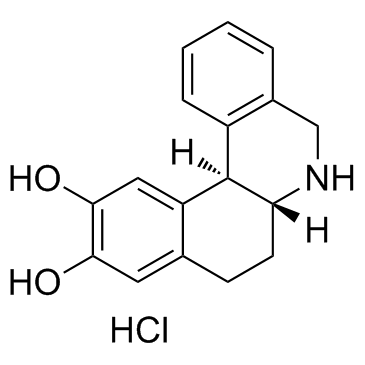158704-02-0
| Name | (+)-Dihydrexidine hydrochloride |
|---|
| Description | (+)-Dihydrexidine hydrochloride is a dopamine D1 receptor agonist with an EC50 of 72± 21 nM. |
|---|---|
| Related Catalog | |
| Target |
EC50: 72±21 nM (Dopamine D1 receptor)[1] |
| In Vitro | (+)-Dihydrexidine hydrochloride (DHX) is a high-potency, bioavailable D1 dopamine receptor agonist. (+)-Dihydrexidine is screened for activity against 40 other binding sites, and is inactive (IC50 greater than 10 microM) against all except D2 dopamine receptors (IC50=130 nM) and alpha 2 adrenoreceptors (IC50=230 nM). Dihydrexidine competes stereoselectively and potently for D1 binding sites in rat striatal membranes labeled with [3H]SCH23390 with an IC50 of about 10 nM compared to about 30 nM for the prototypical D1 agonist SKF38393[2]. |
| In Vivo | To examine the functional state of striatal neurons in response to D1 receptor activation, AC5+/+ and AC5-/- mice are injected with the D1 agonist (+)-Dihydrexidine (30 mg/kg, i.p.) and obtained the dorso-lateral striatum and NAc, separately, 45 min later for RT-PCR analysis. These experiments reveal that (+)-Dihydrexidine -triggered induction of the immediate early genes, c-fos, egr-1, and junB, in the NAc is markedly enhanced in AC5-/- mice compared with that in AC5+/+ mice, while the induction in the dorso-lateral striatum is suppressed in AC5-/- mice[3]. |
| Animal Admin | Mice[3] AC5-/- mice are backcrossed to the C57BL/6J strain for 9 or 10 generations to obtain heterozygote N9 or N10 mice. Mice are treated with (+)-Dihydrexidine (30 mg/kg, i.p.)[3]. |
| References |
| Molecular Formula | C17H18ClNO2 |
|---|---|
| Molecular Weight | 303.78 |
